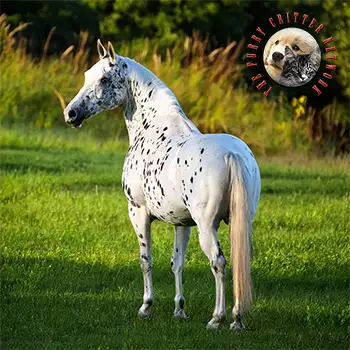History
The Appaloosa's heritage is as colorful and unique as its coat pattern. Usually noticed and recognized because of its spots and splashes of color, the abilities and beauty of this breed are more than skin deep.
Appaloosas are found in nearly every discipline. Setting speed records on the race track, excelling at advanced levels of dressage, jumping, games, reining, roping, pleasure, endurance and as gentle family horses - any of these roles can be filled by the versatile Appaloosa. Their eager-to-please attitudes and gentle dispositions make them a pleasure to work with in any area.
Humans have recognized and appreciated the spotted horse throughout history. Ancient cave drawings as far back as 20,000 years ago in what is now France depict spotted horses, as do detailed images in Asian and 17th-century Chinese art.
The Spanish introduced horses to North America as they explored the American continents. Eventually, as these horses found their way into the lives of Indians and were traded to other tribes, their use spread until most of the Native American populations in the Northwest were mounted (about 1710).
The Nez Perce of Washington, Oregon and Idaho became especially sophisticated horsemen, and their mounts, which included many spotted individuals, were prized and envied by other tribes. Historians believe they were the first tribe to breed selectively for specific traits - intelligence and speed - keeping the best, and trading away those that were less desirable.
When white settlers came to the Northwest Palouse region, they called the spotted horses "Palouse horses" or "a Palouse horse." Over time the name was shortened and slurred to "Appalousey" and finally "Appaloosa."
During the Nez Perce War of the late 1800's, Appaloosa horses helped the Nez Perce avoid battles and elude the U.S. Cavalry for several months. The tribe fled over 1,300 miles of rugged, punishing terrain under the guidance of the famed Chief Joseph. When they were defeated in Montana, their surviving horses were surrendered to soldiers, left behind or dispersed to settlers. Nothing was done to preserve the Appaloosa until 1938, when a group of dedicated horsemen formed the Appaloosa Horse Club for the preservation and improvement of the diminishing spotted horse.
Behavior
Appaloosas are found in nearly every discipline. Setting speed records on the race track, excelling at advanced levels of dressage, jumping, games, reining, roping, pleasure, endurance and as gentle family horses - any of these roles can be filled by the versatile Appaloosa. Their eager-to-please attitudes and gentle dispositions make them a pleasure to work with in any area.
Function
Appaloosas are used extensively for both Western and English riding. Western competitions include cutting, reining, roping and O-Mok-See sports such as barrel racing (known as the Camas Prairie Stump Race in Appaloosa-only competition) and pole bending (called the Nez Perc Stake Race at breed shows). English disciplines they are used in include eventing, show jumping, and fox hunting. They are common in endurance riding competitions, as well as in casual trail riding. Appaloosas are also bred for horse racing, with an active breed racing association promoting the sport.
Health
Appaloosas have an eightfold greater risk of developing Equine Recurrent Uveitis (ERU) than all other breeds combined. Up to 25 percent of all horses with ERU may be Appaloosas. Uveitis in horses has many causes, including eye trauma, disease, and bacterial, parasitic and viral infections, but ERU is characterized by recurring episodes of uveitis, rather than a single incident. If not treated, ERU can lead to blindness, which occurs more often in Appaloosas than in other breeds.[98] Eighty percent of all uveitis cases are found in Appaloosas with physical characteristics including roan or light-colored coat patterns, little pigment around the eyelids and sparse hair in the mane and tail denoting the most at-risk individuals. Researchers may have identified a gene region containing an allele that makes the breed more susceptible to the disease.
Appaloosas that are homozygous for the leopard complex (LP) gene are also at risk for congenital stationary night blindness (CSNB). This form of night blindness has been linked with the leopard complex since the 1970s, and in 2007 a "significant association" between LP and CSNB was identified. CSNB is a disorder that causes an affected animal to lack night vision, although day vision is normal. It is an inherited disorder, present from birth, and does not progress over time. Studies in 2008 and 2010 indicate that both CSNB and leopard complex spotting patterns are linked to TRPM1.






